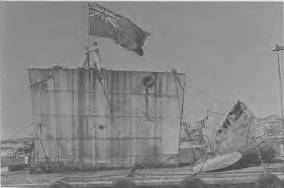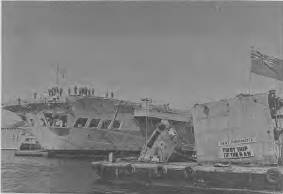- Author
- Lind, L.J.
- Subjects
- History - general
- Tags
-
- RAN Ships
- None noted.
- Publication
- December 1990 edition of the Naval Historical Review (all rights reserved)
The stern section proved more difficult. There was no way of estimating how deep the lower edge of the outboard rudder was buried in the mud. To break the grip of the mud the barge was tilted from side to side. When the section came free it went very close to driving the bow of the barge underwater.
Both barges were drawn out to deep water by the stern hawser and rigged for the voyage down the Hawkesbury River to the sea.
HMAS Parramatta – the Voyage to Sydney Harbour
The Committee learnt much about navigation rules in the next week. Before setting out on the sea voyage to Sydney Harbour the barge was moored at Bayview while it was rigged with navigation lights and other requirements.
On the Wednesday following the salvage we were stunned by a news flash – the barge with the bow and stern of HMAS PARRAMATTA had sunk in seven fathoms of water at her mooring at Bayview. It required another week to raise the barge, carry out repairs and obtain the necessary approval to sail for Sydney.


The last voyage of the torpedo boat destroyer HMAS PARRAMATTA had now captured the media’s attention. In company with Lieutenant Commander Peter Churchill I boarded the barge off Sydney Heads and from there to Garden Island we were escorted by a small fleet of onlooker craft and top cover of five helicopters. The Navy had agreed to honour the remains of its first ship with a flagship salute. This had been arranged with Captain Andrew Robertson of HMAS SYDNEY and as the barge, suitably festooned with a White Ensign and bunting passed the bows of the aircraft carrier the ensign was dipped and a salute was fired.
PARRAMATTA’s bow and stern remained at the Navy Depot at Rydalmere for two weeks while the land leg of her delivery was arranged. Sydney Wharf and Bridge had asked to be relieved of the road journey on the grounds that the sinking at Bayview had incurred them in unanticipated expenditure.
An Italian migrant who had prospered in heavy road haulage offered to undertake the last journey at no cost and his offer was accepted by Parramatta City Council.
Parramatta takes to the Road
My knowledge of the regulations covering the moving of large loads over public roads increased greatly in the days that followed. I found myself involved with the State Police, the Electricity Authority and the Main Roads Board. Wide and high loads may be moved on public roads only between the hours of 4am and 6am. A police escort of four motor cyclists was required as escort. (The charge was $5 per motor cyclist.)

If the height of the load exceeded 20 feet the Electricity Authority would need to raise all power lines along the route. (PARRAMATTA, even with the low-loader’s tyres deflated, exceeded the height by 18 inches.)
The route from Rydalmere led up the hill from the Navy Depot and turned into Victoria Road, one of Sydney’s main traffic arteries, and continued along this road for three miles before turning into a maze of small and narrow streets which eventually reached the Parramatta Council Depot.
We arrived at the Navy Depot on a cold and dark August morning and joined the small knot of transport drivers, police and Council officers. At 4.10 am we were ready to proceed but the Electricity Authority team were not in sight. The fifteen minutes delay was to cause real trouble on Victoria Road.
The convoy, led by two police motor cyclists with their blue lights rotating, eventually moved off at 4.25 am followed by two electricity gantry trucks which stopped every fifty yards to lift power lines. This stop-start procession continued until we reached Victoria Road at 7. 10 am, and it was here our troubles really started.




